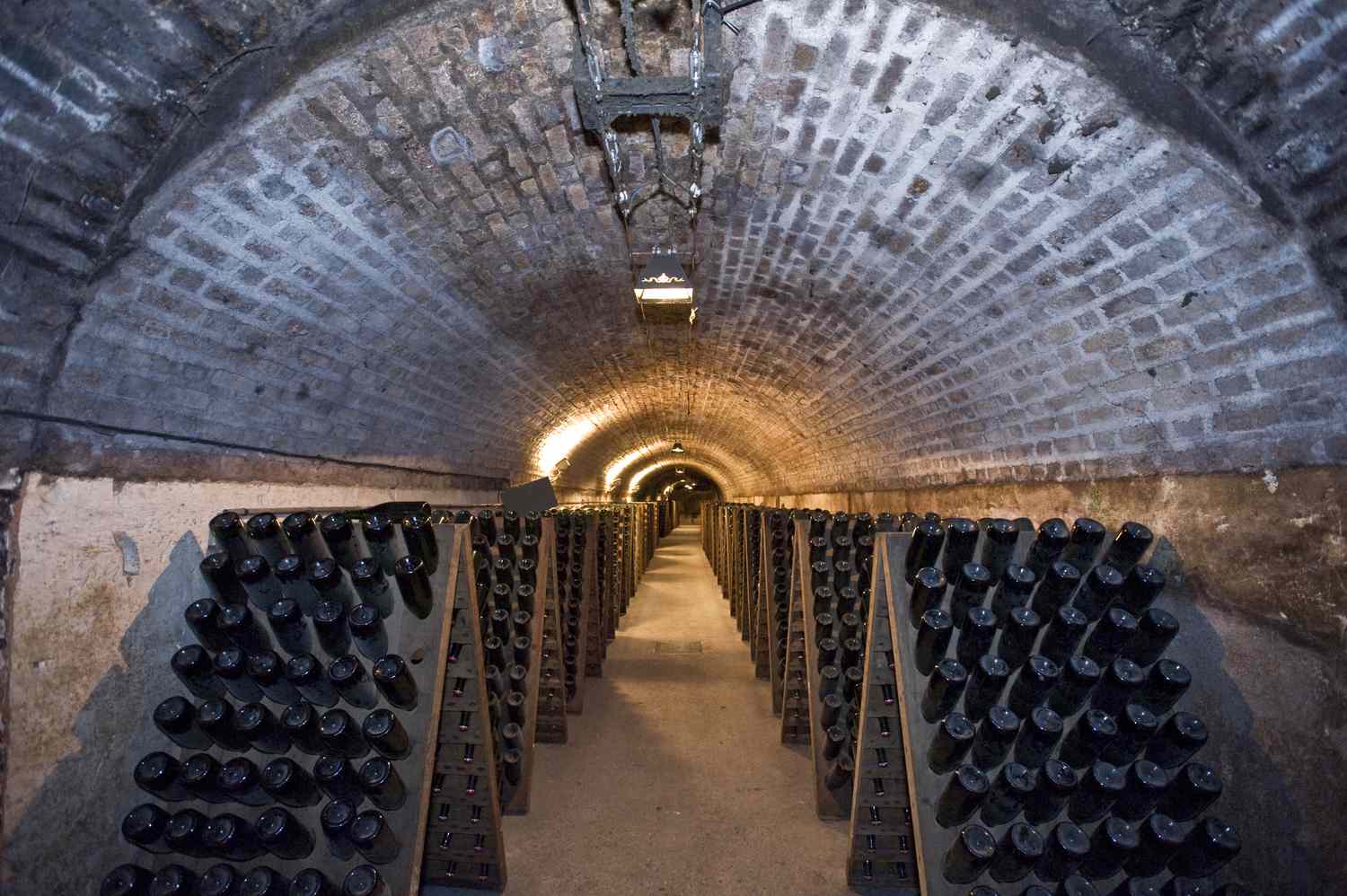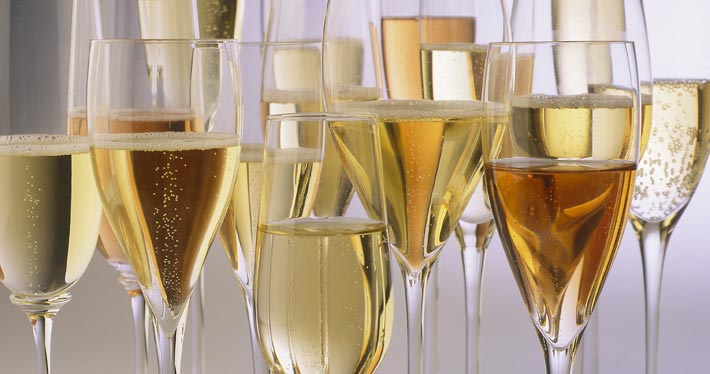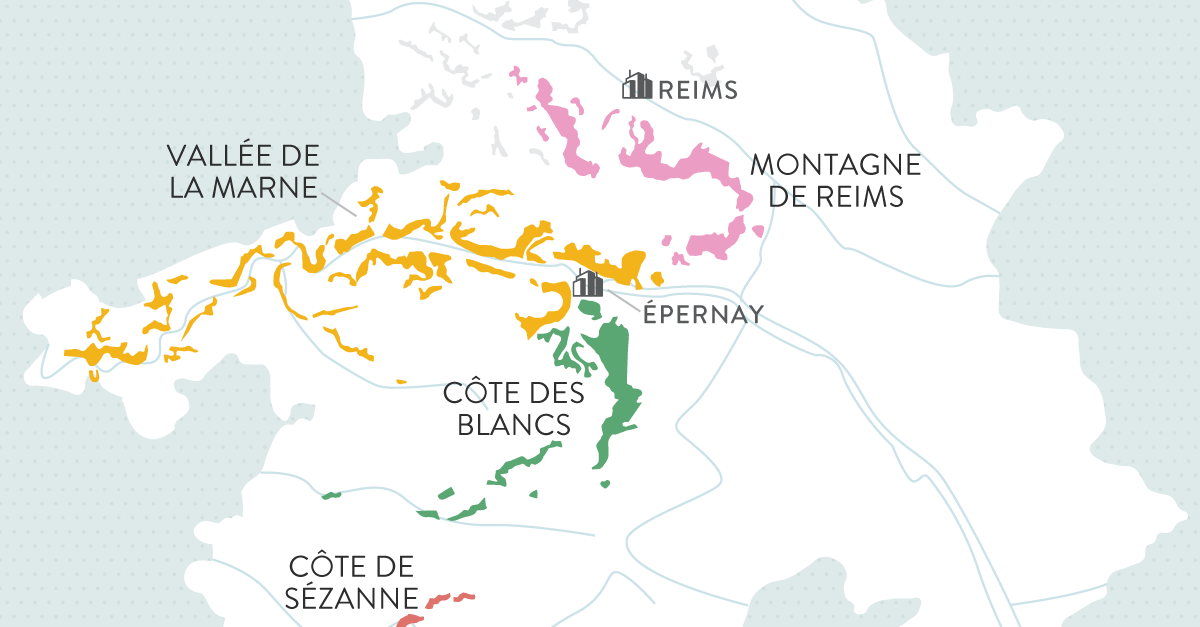May 24, 2024
Champagne Your Ultimate Guide

Where is Champagne from?
Champagne is a sparkling wine produced exclusively in the Champagne region of France. It is made using a unique method of secondary fermentation in the bottle, which creates the signature bubbles that make it so distinctive. Champagne is typically made from a blend of Chardonnay, Pinot Noir, and Pinot Meunier grapes, although some producers use only one or two of these varieties.
The region's cool climate and chalky soil contribute to the wine's complex flavor profile, which often includes notes of citrus, green apple, and toasted bread. Champagne is celebrated around the world as a symbol of luxury, celebration, and refinement.
Champagne production method:
The Champagne method, also known as the Traditional Method, involves a second fermentation that takes place inside each individual bottle. After the initial fermentation, a blend of still wines is created and bottled with yeast and sugar. This triggers a secondary fermentation inside the bottle, producing carbon dioxide and creating the bubbles. The bottles are then aged on their sides for at least 15 months (for non-vintage Champagne) and up to several decades (for vintage Champagne). The lees (dead yeast cells) are then removed through a process called riddling, and the wine is topped off with a mixture of sugar and wine, known as the dosage, before being corked and labeled.

Photo source: mycupofwine.com
The Grapes of Champagne:
Chardonnay:
Although it is the least planted of the three primary grapes used in Champagne production, Chardonnay remains a critical component that contributes elegance and finesse to the final blend. Grown in the cooler northern region, Chardonnay grapes exhibit high acidity levels that are crucial for producing wines with longevity and preventing a flabby taste in the finished product. Champagnes with a higher proportion of Chardonnay tend to be light, fresh, and make excellent aperitifs. When Champagne is made exclusively from Chardonnay, it is known as Blanc de Blancs, meaning "white of whites."
Pinot Noir:
Pinot Noir is the most widely planted grape in Champagne due to its ability to provide complexity and character to the wine. While it does not have the same high acidity levels as Chardonnay, Pinot Noir adds weighty flavors, contributes body and strength, and provides structure to the final blend. Bollinger is an excellent illustration of a classic Pinot Noir-dominant blend, highlighting the grape's ability to deliver depth and richness to the Champagne.
Pinot Meunier:
Pinot Meunier, the least recognized of the three primary grapes used in Champagne production, is renowned for its softness and fruitiness. Despite being less well-known, it makes up around one-third of all Champagne plantings. Pinot Meunier is named after the French word for "miller," as the white underside of its leaves looks like it has been dusted with flour. With a little more acidity than Pinot Noir, Pinot Meunier adds brightness to the Champagne, enhancing its overall freshness. Blanc de Noirs Champagne contains only Pinot Noir and/or Pinot Meunier, resulting in a white wine made from black grapes.

Types of Champagne:
A range of Champagne varieties are available, and each offers a distinct flavor profile. These include:
Blanc de Blancs Champagne:
Blanc de Blancs is a French phrase that translates to "white from whites." This term refers to a type of Champagne that is made entirely from Chardonnay grapes. Blanc de Blancs champagnes are known for their distinctive fruit flavours reminiscent of lemon and apple.
Blanc de Noir Champagne:
Blanc de Noirs translates to "white from blacks," and refers to a type of wine made exclusively from black grapes - Pinot Noir and Pinot Meunier. Blanc de Noirs champagnes are renowned for their fruity notes of white raspberry and strawberry.
Rosé Champagne:
To create the pink-colored/rose champagne, a small amount of red Pinot Noir or Pinot Meunier wine is typically added to the blanc Champagne blend. It's worth noting that the red wine used for Champagne is distinct from the Pinot Noir you may be familiar with. Its primary role is to imbue the champagne with bright and pure fruit flavors, such as strawberry and raspberry.
Prestige Cuvée:
Prestige Champagne Cuvée is a type of champagne produced by the most renowned and established champagne houses, often from a blend of the highest quality grapes grown in the most exceptional vineyards. They are considered the pinnacle of luxury champagne due to their complex flavor profile, exquisite aroma, and rare availability. These champagnes are produced in limited quantities and are aged for an extended period, sometimes up to a decade or more, to achieve their unique taste. The price of prestige cuvées is typically higher than that of other types of champagne due to the exceptional quality and rarity of the grapes used in their production.
Champagne Sub-Regions:
Champagne is divided into five sub-regions, each with a unique style that is influenced by its geography, soil, and climate.

Montagne de Reims:
Known for producing powerful, full-bodied Champagnes dominated by Pinot Noir. The region's steep slopes and limestone soils contribute to the wines' rich, fruit-forward flavors.
Cote des Blancs:
The region produces Champagne made primarily from Chardonnay, resulting in elegant, crisp, and mineral-driven wines. The chalky soils of Cote des Blancs contribute to the wine's unique flavor profile.
Vallee de la Marne:
Known for producing well-balanced Champagnes with fruit-forward flavors, Vallee de la Marne is dominated by Pinot Meunier. The region's clay and sand soils contribute to the wine's round and fruity characteristics.
Cote des Bar:
Located in the southernmost part of Champagne, the region is known for producing Pinot Noir-dominant Champagnes. The warmer climate and clay-limestone soils result in powerful and fruity wines.
Aube:
The region is known for producing elegant and complex Champagnes that are a blend of Pinot Noir, Pinot Meunier, and Chardonnay. The region's unique Kimmeridgian soils contribute to the wine's mineral-driven flavor profile.
Champagne Dosage or sweetness level:
Dosage is a crucial element in Champagne-making, where sweetness in the form of sugar is added to balance out the acidity of the wine. Due to the cool-climate nature of the champagne region, the grapes often end up with less sugar, resulting in aggressively acidic wine. The dosage serves as a simple corrective measure that can nullify intense acidity or introduce a desirable level of sweetness. The ‘dosage’ is added after the secondary fermentation process.
The amount of dosage added determines the sweetness level of the final product, which is defined by a scale ranging from sweetest to driest, though the terminology used can be confusing.
Brut Nature/Brut Zero – Less than 3 grams of sugar per litre.
Extra Brut – less than 6 grams of sugar per litre.
Brut – under 15 grams of sugar per litre.
Extra Sec/Extra Dry – between 12 to 20 grams of sugar per litre.
Sec – between 17 to 35 grams of sugar per litre.
Demi-sec – between 33 to 50 grams of sugar per litre.
Doux – more than 50 grams of sugar per litre.
Champagne Serving temperature:
Champagne is traditionally served chilled and in general, non-vintage champagne should be served between 7-10°C to bring out its crisp, fruity flavors.
Vintage champagnes and higher-end cuvees can be served slightly warmer, between 10-13°C, to allow their more complex flavors to shine.
Over-chilling champagne can dull the flavors and aromas so it is important to not over-chill the champagne. on the contrary, serving the champagne too warm can cause it to taste flat so getting it right is very important.
Notable Champagne Producers:
Dom Perignon:
Named after the Benedictine monk who is said to have invented champagne, Dom Pérignon is produced by Moët & Chandon and is considered one of the finest prestige cuvées in the world. The champagne is known for its complex flavour profile, with notes of fruit, honey, and brioche.
Shop all Dom Perignon wines by clicking here.
Ruinart:
Ruinart is one of the oldest and most prestigious champagne houses in France. It was established in 1729 by Nicolas Ruinart, making it the first champagne house to be founded. The house is renowned for its commitment to producing elegant and refined champagnes that express the unique terroir of the Champagne region. Ruinart champagnes are known for their delicate, floral character, with a fine balance of richness and freshness.\\
Shop all Ruinart wines by clicking here.
Moët & Chandon:
One of the most famous champagne houses, Moët & Chandon was established in 1743 and is renowned for producing elegant and refined champagnes with rich fruit flavors and fine bubbles. Its signature wine is the Dom Perignon, which is named after a 17th-century monk who is believed to have helped develop the traditional champagne-making method.
Veuve Clicquot:
Founded in 1772, Veuve Clicquot is famous for producing premium-quality champagnes with a distinct balance of richness and freshness. The house is credited with inventing the riddling process, which is used to remove sediment from the champagne during the production process.
Krug:
Established in 1843, Krug produces some of the most sought-after champagnes in the world. The house is known for its commitment to using only the finest grapes, and its champagnes are aged for an extended period to achieve a rich, complex flavor profile.
Louis Roederer:
Founded in 1776, Louis Roederer is a family-owned champagne house that produces a range of champagnes, including the famous Cristal. The house is known for its commitment to producing champagnes that express the unique terroir of the Champagne region.
Bollinger:
Established in 1829, Bollinger is renowned for producing powerful and complex champagnes with a distinctive Pinot Noir character. The house is also famous for being the champagne of choice for James Bond in the 007 movies.
Pol Roger:
Founded in 1849, Pol Roger is a boutique champagne house that produces a range of high-quality champagnes, including the famous Cuvée Sir Winston Churchill. The house is known for its commitment to producing champagnes with a fresh, crisp, and elegant character.
Taittinger:
Established in 1734, Taittinger is one of the oldest champagne houses in France. The house is known for producing elegant and refined champagnes with a delicate, floral character. Its signature wine is the Comtes de Champagne, a prestige cuvée made from the finest grapes.
Laurent-Perrier:
Founded in 1812, Laurent-Perrier is a family-owned champagne house that produces a range of elegant and refined champagnes. The house is known for its commitment to using only the finest grapes and producing champagnes with a delicate, fresh, and crisp character.
Piper-Heidsieck:
Established in 1785, Piper-Heidsieck is one of the oldest and most prestigious champagne houses in France. The house is known for producing rich and complex champagnes with a distinctive Pinot Noir character, and its signature wine is the Cuvée Rare, a prestige cuvée made from the finest grapes.
